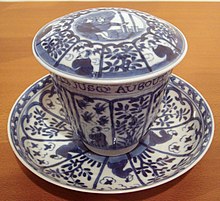
Back Chinesisches Auftragsporzellan German Porcelana china de exportación Spanish Porcellana cinese da esportazione Italian Chine de commande Dutch Kinesisk eksportporselen NB Chine de commande Polish


Chinese export porcelain includes a wide range of Chinese porcelain that was made (almost) exclusively for export to Europe and later to North America between the 16th and the 20th century. Whether wares made for non-Western markets are covered by the term depends on context. Chinese ceramics made mainly for export go back to the Tang dynasty if not earlier, though initially they may not be regarded as porcelain.
It is typically not used as a descriptive term for the much earlier wares that were produced to reflect Islamic taste and exported to the Middle East and Central Asia, though these were also very important, apparently driving the development of Chinese blue and white porcelain in the Yuan and Ming dynasties (see Chinese influences on Islamic pottery). Longquan celadon, which is mostly not porcelain on Western definitions, is one of the wares to produce large dishes that reflected Islamic dining habits, rather than the deeper bowls used by the Chinese. In general, wares made for export, especially in the early periods, were "mainly strong and rather roughly-finished articles",[1] compared to those for the elite domestic market, to allow for the stresses of transport, and less sophisticated customers.
Other types of Chinese wares made mainly for export to other markets may or may not be covered; they are certainly described as export wares in discussing the Chinese industry, but much discussion in Western sources only refers to wares intended for Europe. The other types include Swatow ware (c. 1575–1625), made for South-East Asian and Japanese markets, and Tianqi porcelain, made mainly for the Japanese market in the 17th century. Chinese celadons were exported to most of Eurasia, but not Europe, between roughly the Tang and the early Ming dynasties.
It took some time for feedback from export markets to influence the shapes and decoration of the Chinese product, especially in earlier periods, and with distant markets such as Europe. Initially markets were sent what the Chinese market, or older exports markets, liked. With the increasing reach of European trading companies, especially the Dutch VOC, this became possible, and eventually even specific armorial designs could be ordered from Europe.
- ^ Hobson, R. L., The Wares of the Ming Dynasty, "Preface", 2nd edn, 1962
© MMXXIII Rich X Search. We shall prevail. All rights reserved. Rich X Search